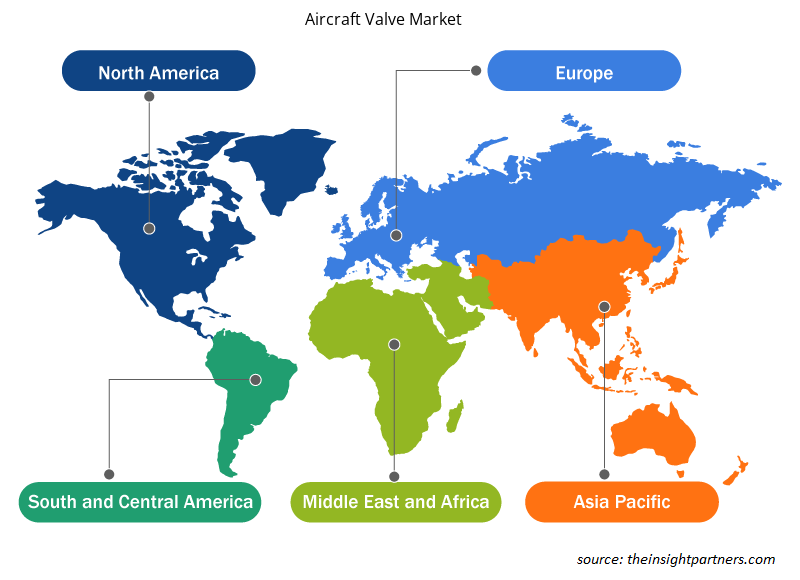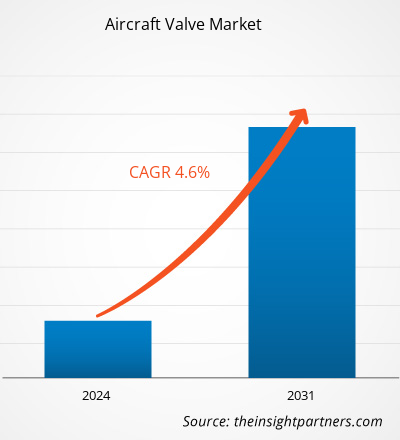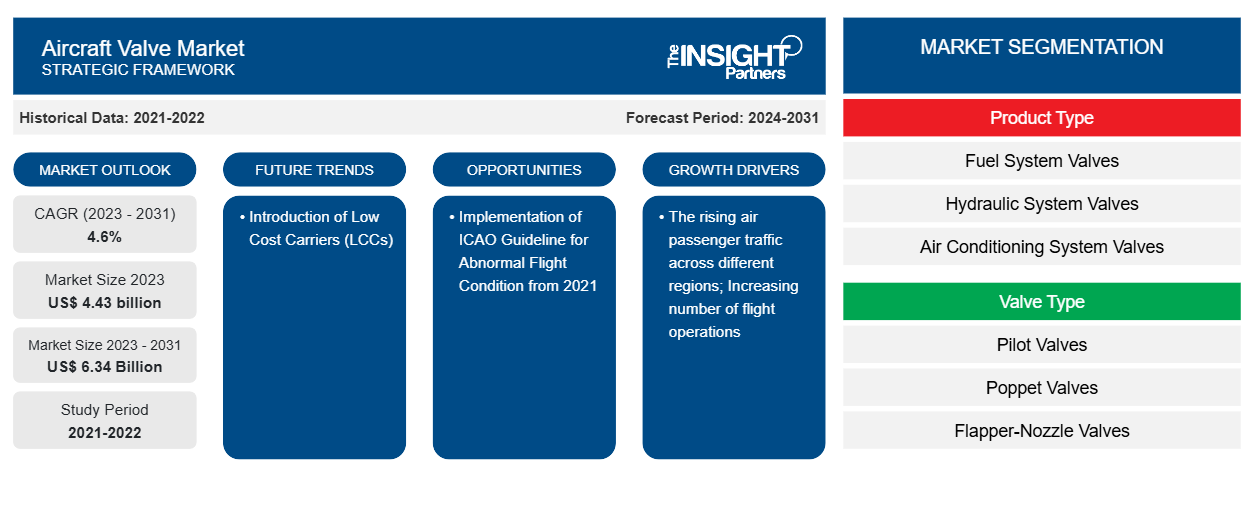Das Marktvolumen für Flugzeugventile soll von 4,43 Milliarden US-Dollar im Jahr 2023 auf 6,34 Milliarden US-Dollar im Jahr 2031 anwachsen. Für den Markt wird für den Zeitraum 2023–2031 eine durchschnittliche jährliche Wachstumsrate (CAGR) von 4,6 % erwartet.
Einer der wichtigsten Trends auf dem Markt für Flugzeugventile ist die Nachfrage aus MRO-Operationen aufgrund der steigenden Zahl von Flugzeugoperationen weltweit. Darüber hinaus ist der Anstieg mehrerer alter Flugzeugflotten, die regelmäßig gewartet werden müssen, ein weiterer wichtiger Faktor, der den Markt für Flugzeugventile von 2023 bis 2031 wahrscheinlich antreiben wird.
Marktanalyse für Flugzeugventile
Die Luft- und Raumfahrt- und Verteidigungsindustrie weltweit umfasst eine Reihe etablierter Flugzeughersteller (OEMs), die einen beträchtlichen Marktanteil auf dem jeweiligen Flugzeugmarkt haben. Da es auf dem Markt eine große Anzahl von Flugzeugventilherstellern gibt, sowohl kleine als auch große Marken, verfügen die Flugzeughersteller über eine erhebliche Verhandlungsmacht, um Flugzeugventile hoher Qualität zu einem wettbewerbsfähigen Preis zu beschaffen. Infolgedessen ist die Verhandlungsmacht der Käufer auf dem Flugzeugventilmarkt aufgrund ihrer funktionalen Anforderungen und der Präsenz einer beträchtlichen Anzahl von Lieferanten zugunsten der Käufer geneigt. Darüber hinaus wird erwartet, dass die Verhandlungsmacht der Käufer im Prognosezeitraum aufgrund der Entwicklung von OEM-Komponenten und Flugzeugkomponenten hoch bleibt.
Marktübersicht für Flugzeugventile
Die zunehmende Beschaffung neuer Flugzeuge und die steigende Nachfrage nach MRO-Diensten durch Endnutzer im kommerziellen und militärischen Sektor werden voraussichtlich die Marktnachfrage nach Flugzeugventilen in den kommenden Jahren ankurbeln. Mehrere Hersteller von Flugzeugventilen konzentrieren sich auf die Beschaffung von Komponenten von Rohstofflieferanten und die Lieferung der Montageventile in einem System an Flugzeug-OEMs und MROs. Zu den Flugzeug-OEMs zählen Unternehmen wie Boeing, Airbus und Universal Helicopters, die diese Flugzeugventile weiter in ihre Flugzeuge integrieren und sie sowohl an kommerzielle als auch an militärische Endnutzer liefern. MROs wie AAR Corporation und Lufthansa Technik bieten diesen Endnutzern verschiedene Wartungs-, Reparatur- und Überholungsdienste an. Das Wachstum des Flugzeugventilmarktes ist auf einige der folgenden Schlüsselfaktoren zurückzuführen:
- Die steigenden Auslieferungen ziviler Flugzeuge und Hubschrauber
- Die steigende Zahl der Verträge für Militärflugzeuge und Hubschrauber
- Wachstum in der Flugzeug-MRO-Industrie
Passen Sie diesen Bericht Ihren Anforderungen an
Sie erhalten kostenlos individuelle Anpassungen an jedem Bericht, einschließlich Teilen dieses Berichts oder einer Analyse auf Länderebene, eines Excel-Datenpakets sowie tolle Angebote und Rabatte für Start-ups und Universitäten.
-
Holen Sie sich die wichtigsten Markttrends aus diesem Bericht.Dieses KOSTENLOSE Beispiel umfasst eine Datenanalyse von Markttrends bis hin zu Schätzungen und Prognosen.
Treiber und Chancen auf dem Flugzeugventilmarkt
Steigende Flugzeugauslieferungen weltweit
Die stetig steigende Zahl der Flugzeugauslieferungen ist einer der Hauptfaktoren, die das Wachstum des Flugzeugventilmarktes weltweit vorantreiben. So lieferten beispielsweise zwei der größten Flugzeuggiganten, nämlich Boeing und Airbus, im Jahr 2023 rund 1.263 Verkehrsflugzeuge aus, verglichen mit 1.141 Verkehrsflugzeugen im Jahr 2022. Darüber hinaus ist die steigende Beschaffung von Militärflugzeugen ein weiterer wichtiger Faktor, der die Integration von Ventilen in die Luftfahrtindustrie unterstützt.
Wachstum im Luftfahrt-MRO-Sektor dürfte künftig Chancen bieten
Die wachsende Flugzeug-MRO-Branche wird im Prognosezeitraum voraussichtlich enorme Chancen für Marktanbieter schaffen. Dies wird zusätzlich durch die wachsende globale Flugzeugflotte unterstützt, die aufgrund des kontinuierlichen Flugbetriebs eine konstante Nachfrage nach MRO-Operationen erzeugt. Darüber hinaus wird die Notwendigkeit regelmäßiger Wartungskontrollen für bestehende Flugzeugflotten in den kommenden Jahren voraussichtlich zu einer neuen Nachfrage nach Flugzeugventilen führen.
Segmentierungsanalyse des Marktberichts für Flugzeugventile
Wichtige Segmente, die zur Ableitung der Marktanalyse für Flugzeugventile beigetragen haben, sind Produkttyp, Ventiltyp, Flugzeugtyp, Endbenutzer und Geografie.
- Basierend auf dem Produkttyp wurde der Markt für Flugzeugventile in Kraftstoffsystemventile, Hydrauliksystemventile, Klimaanlagenventile, Schmiersystemventile und andere unterteilt . Das Segment der Kraftstoffsystemventile hatte im Jahr 2023 einen größeren Marktanteil.
- Nach Ventiltyp wurde der Markt in Pilotventile, Tellerventile, Klappen-Düsen-Ventile und andere segmentiert. Das Segment der Tellerventile hatte im Jahr 2023 den größten Marktanteil.
- In Bezug auf den Flugzeugtyp wurde der Markt in Starrflügel- und Drehflügelflugzeuge unterteilt. Das Starrflügelsegment dominierte den Markt im Jahr 2023.
- In Bezug auf die Endnutzer hat sich der Markt in OEMs und MRO aufgespalten. Das OEM-Segment dominierte den Markt im Jahr 2023.
Marktanteilsanalyse für Flugzeugventile nach Geografie
Der geografische Umfang des Marktberichts für Flugzeugventile ist hauptsächlich in fünf Regionen unterteilt: Nordamerika, Europa, Asien-Pazifik, Naher Osten und Afrika sowie Südamerika.
Nordamerika dominierte den Markt für Flugzeugventile im Jahr 2023, während die Region Asien-Pazifik im Prognosezeitraum voraussichtlich ein deutliches Wachstum verzeichnen wird. Das Wachstum des Fluggastverkehrs, die Nachfrage der Fluggesellschaften nach Ersatz für ihre alternde Flotte und der steigende Auftragsbestand bei Flugzeugen zählen zu den wichtigsten Wachstumstreibern für den Markt für Flugzeugventile in Nordamerika. Aufgrund dieses Faktors sind Flugzeuge bei der nordamerikanischen Bevölkerung das bevorzugte Transportmittel für Inlandsreisen. Dies hat zu einem höheren Fluggastverkehr in der Region geführt. Die hohen Anforderungen an den Passagierverkehr werden durch die starken wirtschaftlichen Bedingungen in der nordamerikanischen Region unterstützt, die zu erhöhten Ausgaben der Verbraucher für Reisen geführt haben. Daher steigen die Anforderungen an die Herstellung von Flugzeugen, was wiederum die Integration von Flugzeugventilen in die Flugzeuge erfordert.
Neuigkeiten und aktuelle Entwicklungen zum Flugzeugventilmarkt
Der Markt für Flugzeugventile wird durch die Erfassung qualitativer und quantitativer Daten nach Primär- und Sekundärforschung bewertet, die wichtige Unternehmensveröffentlichungen, Verbandsdaten und Datenbanken umfasst. Im Folgenden finden Sie eine Liste der Entwicklungen auf dem Markt für Flugzeugventile und Strategien:
- Im September 2022 gab Parker Hannifin Corporation, der weltweit führende Anbieter von Antriebs- und Steuerungstechnologien, bekannt, dass die Übernahme von Meggitt PLC für rund 7,8 Milliarden US-Dollar abgeschlossen wurde. (Quelle: Parker Hannifin Corporation, Pressemitteilung/Unternehmenswebsite/Newsletter)
- Im Mai 2023 schlossen Triumph Group Inc und Moog Inc einen Fünfjahresvertrag über die Bereitstellung von Wartungs-, Reparatur- und Überholungslösungen (MRO) für Boeing 787-Fahrwerke und Laderaumtür-Betätigungssysteme über das Moog Total Support Program (MTS) für einen Betreiber im asiatisch-pazifischen Raum, der mehr als 40 Boeing 787 im Einsatz hat. (Quelle: Triumph Group Inc, Pressemitteilung/Unternehmenswebsite/Newsletter)
Regionale Einblicke in den Flugzeugventilmarkt
Die regionalen Trends und Faktoren, die den Flugzeugventilmarkt während des Prognosezeitraums beeinflussen, wurden von den Analysten von Insight Partners ausführlich erläutert. In diesem Abschnitt werden auch die Marktsegmente und die Geografie des Flugzeugventilmarkts in Nordamerika, Europa, im asiatisch-pazifischen Raum, im Nahen Osten und Afrika sowie in Süd- und Mittelamerika erörtert.

- Erhalten Sie regionale Daten zum Flugzeugventilmarkt
Umfang des Marktberichts für Flugzeugventile
| Berichtsattribut | Details |
|---|---|
| Marktgröße im Jahr 2023 | 4,43 Milliarden US-Dollar |
| Marktgröße bis 2031 | 6,34 Milliarden US-Dollar |
| Globale CAGR (2023 - 2031) | 4,6 % |
| Historische Daten | 2021-2022 |
| Prognosezeitraum | 2024–2031 |
| Abgedeckte Segmente |
Nach Produkttyp
|
| Abgedeckte Regionen und Länder |
Nordamerika
|
| Marktführer und wichtige Unternehmensprofile |
|
Marktteilnehmerdichte für Flugzeugventile: Auswirkungen auf die Geschäftsdynamik verstehen
Der Markt für Flugzeugventile wächst rasant, angetrieben durch die steigende Nachfrage der Endnutzer aufgrund von Faktoren wie sich entwickelnden Verbraucherpräferenzen, technologischen Fortschritten und einem größeren Bewusstsein für die Vorteile des Produkts. Mit steigender Nachfrage erweitern Unternehmen ihr Angebot, entwickeln Innovationen, um die Bedürfnisse der Verbraucher zu erfüllen, und nutzen neue Trends, was das Marktwachstum weiter ankurbelt.
Die Marktteilnehmerdichte bezieht sich auf die Verteilung der Firmen oder Unternehmen, die in einem bestimmten Markt oder einer bestimmten Branche tätig sind. Sie gibt an, wie viele Wettbewerber (Marktteilnehmer) in einem bestimmten Marktraum im Verhältnis zu seiner Größe oder seinem gesamten Marktwert präsent sind.
Die wichtigsten auf dem Markt für Flugzeugventile tätigen Unternehmen sind:
- Raytheon Technologies Corp
- Crissair Inc
- Eaton
- Honeywell International Inc
- ITT Inc
- Moog Inc
Haftungsausschluss : Die oben aufgeführten Unternehmen sind nicht in einer bestimmten Reihenfolge aufgeführt.

- Überblick über die wichtigsten Akteure auf dem Markt für Flugzeugventile
Marktbericht zu Flugzeugventilen – Umfang und Ergebnisse
Der Bericht „Marktgröße und Prognose für Flugzeugventile (2021–2031)“ bietet eine detaillierte Analyse des Marktes, die die folgenden Bereiche abdeckt:
- Marktgröße und Prognose auf globaler, regionaler und Länderebene für alle wichtigen Marktsegmente, die im Rahmen des Projekts abgedeckt sind
- Marktdynamik wie Treiber, Beschränkungen und wichtige Chancen
- Wichtige Zukunftstrends
- Detaillierte Porter's Five Forces Analyse
- Globale und regionale Marktanalyse mit wichtigen Markttrends, wichtigen Akteuren, Vorschriften und aktuellen Marktentwicklungen
- Branchenlandschaft und Wettbewerbsanalyse, einschließlich Marktkonzentration, Heatmap-Analyse, prominenten Akteuren und aktuellen Entwicklungen
- Detaillierte Firmenprofile mit SWOT-Analyse
- Historische Analyse (2 Jahre), Basisjahr, Prognose (7 Jahre) mit CAGR
- PEST- und SWOT-Analyse
- Marktgröße Wert/Volumen – Global, Regional, Land
- Branchen- und Wettbewerbslandschaft
- Excel-Datensatz
Aktuelle Berichte
Erfahrungsberichte
Grund zum Kauf
- Fundierte Entscheidungsfindung
- Marktdynamik verstehen
- Wettbewerbsanalyse
- Kundeneinblicke
- Marktprognosen
- Risikominimierung
- Strategische Planung
- Investitionsbegründung
- Identifizierung neuer Märkte
- Verbesserung von Marketingstrategien
- Steigerung der Betriebseffizienz
- Anpassung an regulatorische Trends























 Kostenlose Probe anfordern für - Markt für Flugzeugventile
Kostenlose Probe anfordern für - Markt für Flugzeugventile